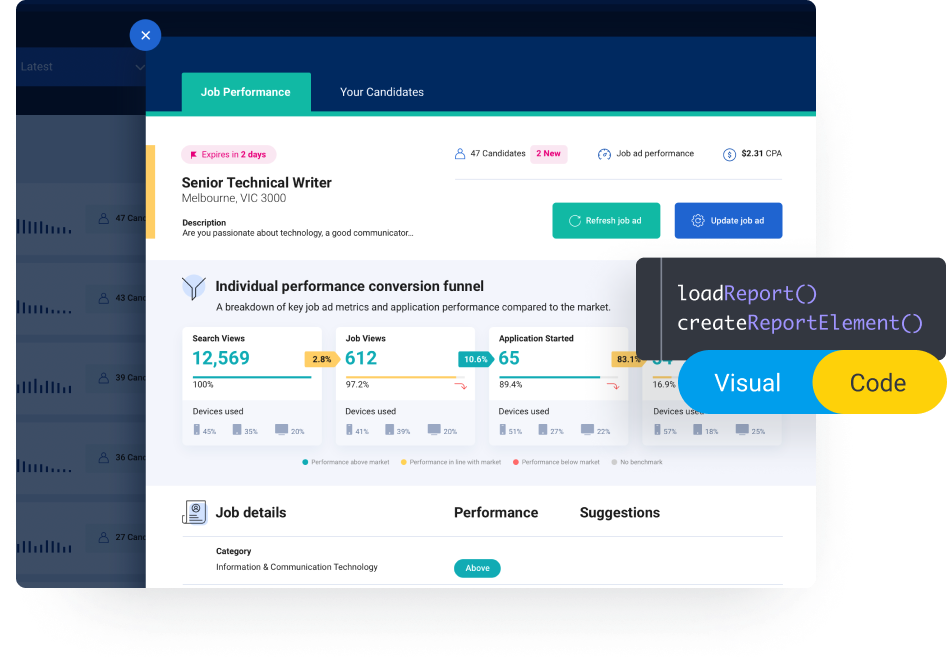
5 Benefits of Low-Code, No-Code BI Solutions
Extensive coding was once necessary for software development. But while businesses still hire software developers to build an application, low code solutions have changed the game. Enterprise applications are now developed without writing a single line of code.
Today, complex applications are developed within hours with low-code or no-code business intelligence (BI) platforms. According to Gartner, 50% of embedded analytics content will be developed by business users by 2025, leveraging a low-code/no-code modular experience. The need to deal with highly complex analytics solution is over.
Enterprises can develop applications with low-code/no-code BI solutions with minimalist efforts. Developers can rapidly build and optimize applications with minimal code. So, what are the best options to get started? This article will discuss the benefits of adopting low-code, no-code solutions to enhance your software's analytics capability.
What is low-code/no-code BI development?
Low-code/no-code development enables application development with little or no coding. It means you can perform common programming tasks with simple drag and drop. Out-of-the-box objects can be expanded upon with minimal coding necessary.
Low-code BI platforms improve development efficiency significantly. No coding is needed to build high-quality analytical user experiences. These tools are the latest innovation in several business intelligence platforms, including Yellowfin, which uses no proprietary languages. Yellowfin Code-Mode utilizes HTML, JavaScript and CSS, while many Yellowfin features are highly customizable through the user interface. To extend Yellowfin features, however, you do need to code for some more advanced use cases.

What is the role of Low-code/No-code in BI?
With low-code/no-code technology, organizations can build intelligent applications with minimum code. These platforms provide a suite of features, making them an interesting solution for business analytics platforms. It's essential to highlight how easy a low-code platform makes it to generate, analyze, store data, and integrate third-party software.
What are the Business Benefits of Low-code/No-code BI Solutions?
Increased Agility
Shifting to a low-code development platform enhances agility. This approach has an immediate impact on application delivery. It allows IT departments to minimize technical debt. Functional simplification is the best benefit.
To overcome slow development, leading companies implement solutions that break from traditional approaches. Businesses are pushing forward with self-service BI, data virtualization, data discovery, agile data warehouse development tools, etc. And in these cases, using Yellowfin becomes beneficial.
More flexibility
Low-code/no-code development tools provide more flexibility for utilizing business data. They provide a free-form approach to data construction, allowing users to collect and merge data from different sources.
You can use this flexibility to develop BI dashboards relevant to the organization, department, and individual level. Low-code application platforms offer low-code integration capabilities. Thus, organizations can connect their disparate on-premises and SaaS-based systems. It helps them provide a unified view of their data.
Moreover, Low-code integrations allow your systems to adapt to the ideas process your business requires despite having to adjust your processes to system functioning. This flexibility provided by low-code business intelligence platforms is essential in today's highly dynamic environment.
Lower Costs
Businesses can experiment with different ideas, but they might prove to be time-consuming or costly. However, building an application with low-code/no-code takes less time than doing things from scratch. It means that the time required for building BI applications is reduced significantly.
Moreover, highly technical resources can be costly due to high demand. But with no code, there are fewer chances for error and more options for who can contribute. Eventually, it will lower the overall cost, as you spend less time fixing errors and less money on hiring team members.
Faster Results
Pandemic has created a rapid need for IT departments to develop new applications. So, these apps can support the remote workforce and help organizations generate revenues. However, it isn't easy to develop such applications with traditional complex BI.
With low-code or no-code BI solutions, you do not need to write custom code. No-code business intelligence tools help you get faster results. It's particularly true for businesses new to BI or that haven't used BI tools in the past.
Moreover, traditional programming languages need expertise. Companies are moving to low-code development tools to create custom applications for reporting, embedded analytics, and data collection.
Enhanced Innovation
According to Forbes members, successful organizations provide their employees with robust tools and technologies to develop their own solutions. Those who provide classes and education are required to perform that successfully.
The increasing demand for no-code platforms and low-code business intelligence solutions makes it easier for organizations to achieve their goals. A low-code/no-code strategy aims to help developers with basic applications.
Also, it relieves them from updating existing programs and resolving errors. This way, developers can spend more time focusing on applications requiring innovation.
No-code development is meant to maximize the alignment between business and IT operations. It enables both parties to make the most of their abilities and unique skill sets.
What are the Reasons to Opt for Low-code/No-code BI solutions?
Here are a few reasons businesses should choose low-code, no-code strategies. Data and embedded analytics leaders should:
- Prepare for growth in the number of developers and business technologists leveraging low-code/no-code technology to widen their use of self-service analytics by offering training in basic software development best practices.
- Evaluate their existing data science and analytics tools. They should innovate startups by providing low-code-enabled configuration experience for building rich analytics-infused applications.
- Foster collaboration by creating cross-functional fusion teams of centralized and decentralized D&A users aligned with the corporate-level value streams.
Ready to Build Applications Faster With Yellowfin?
Low-code/no-code has become a highly demanded approach in application design and delivery in this agile-driven, digitally disrupted world. It has become an evolution in development environments.
Because low-code development tools help you build custom applications for data collection and analytics in less time. It eventually results in lower costs and higher productivity than the traditional approach.
Yellowfin aims to provide maximum flexibility and agility to its customers. The platform lets you create your components based on your requirements. Moreover, it helps create a custom analytics experience for users.
Yellowfin BI: Analytics for Developers and Business Users
Assemble, extend, and embed white-label analytics and dashboards into your software with Yellowfin's toolkit, build-in code editing, and APIs. Deliver exceptional analytics experience with minimal effort.